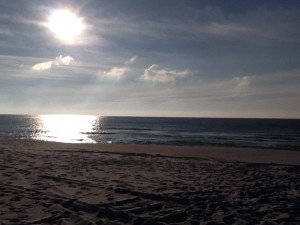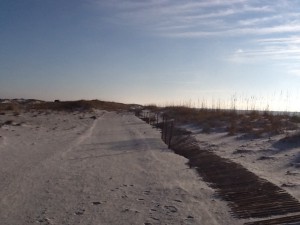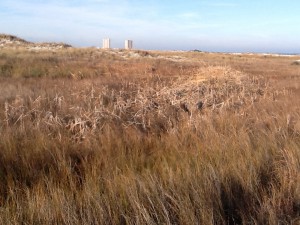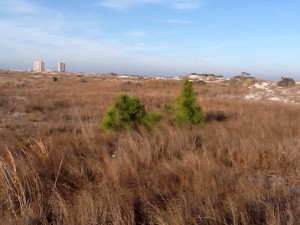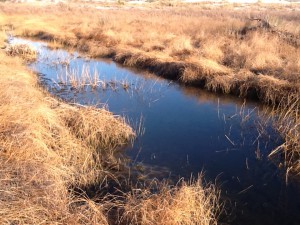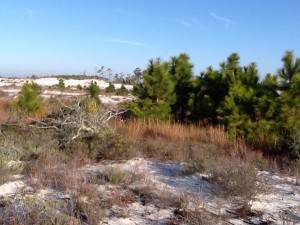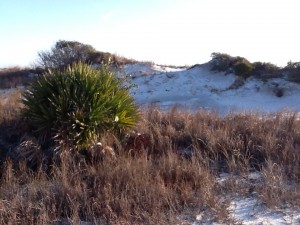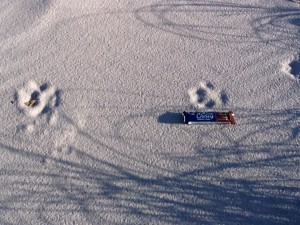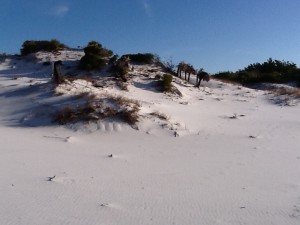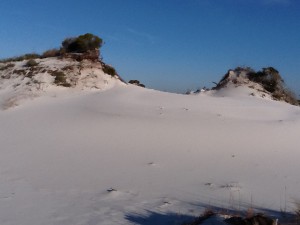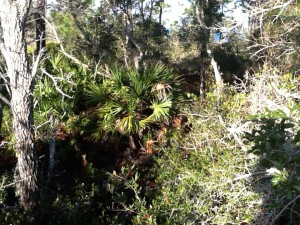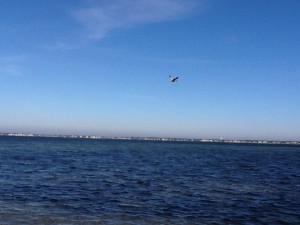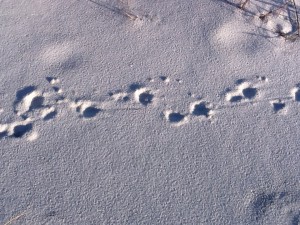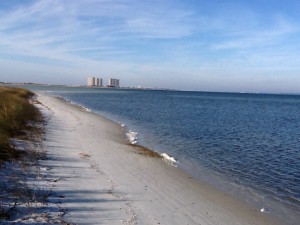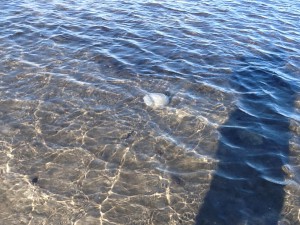Beginning this month we will be posting a series of natural resource articles high lighting Florida’s Panhandle. The photographs and hikes presented in this series are from Escambia and Santa Rosa counties but the same natural places can be found anywhere between the Perdido and Apalachicola Rivers. We hope our readers will visit these places and DISCOVER FLORIDA’S PANHANDLE on their own. This year we will begin at the Gulf of Mexico and visit our BARRIER ISLANDS. We will visit the same location on Santa Rosa Island in Escambia County each month over the course of a year. During this series we should see how things change each season and learn more about our natural places.
Here is the Gulf of Mexico. The northern Gulf is primary sand but their are areas of hard bottom that provide habitat for many of our commercial important fisheries. 450 feet off the shore from this photo is an artificial reef placed by Escambia County for residents and visitors alike to explore. These reefs attract a variety of reef fish and sea turtles and are great for wildlife viewing. Notice how low the sun is in the sky on this winter morning. The shortest day of the year was December 21 (when the sun was it’s lowest) and will be “climbing” as this series continues. Many beach residents use this as their clock!
Our barrier islands are considered the “world’s whitest beaches” and this is because of the high amount of quartz deposited here. In this photograph you can see the water is farther from shore than usual. This is due to the strong north winds blowing water offshore; this happens every winter – but provides feeding opportunities for shorebirds. The sand fencing is used by many of our counties to “kick start” dune restoration.
Beyond the primary dune on this portion of the island you will find low areas known as swales. These “depressions” will fill with water during rain events and provide much needed freshwater for the organisms who live out here. Barrier islands are xeric environments (meaning “desert like”) and freshwater habitats are very important for many creatures. Some of these ponds are ephemeral (meaning non-permanent) and dry up during some periods of the year.
Where the primary dune and swales end the secondary dune fields begin. Because of the primary dunes there is less wind and salt spray which allows different species to take root. The secondary dunes are often identified by their small round shrubs – such as goldenrod and beach heather. These larger plants will trap larger amounts of sand producing larger dunes. On the secondary dunes I usually find lots of tracks. Identifying tracks is difficult (especially in soft sand) but fun. Most of what I saw this winter day were mammals. Raccoons, opossums, and armadillos are very common. Skunks were once common but have been scarce since the hurricane years. Below are tracks of a canine. Many people bring their dogs to the beach but coyote and fox are also found here. These tracks measured about 3.5″ and more round than triangle shaped; suggesting this is a dog.
Beyond the secondary dunes are the largest dunes on the island, some measuring over 50′, these are the tertiary dunes. With the secondary dunes blocking wind and salt spray larger plants still are allowed to grow. Here we find actually trees; pine, live oak, magnolia to name a few. With the loss of primary and secondary dunes the tertiary dunes are exposed to the wind and salt spray of the Gulf side, which puts them at risk. This is why sea oats and primary dunes are protected in most counties.
The large field of tertiary dunes blocks enough wind that forests and salt marshes can establish themselves on the back side of the island. Here the diversity and abundance of wildlife increases. We have found not only the mammals already mentioned but snakes, freshwater turtles and terrapins, and a variety of birds. This winter day I found several small woodland and mocking birds. Some of our islands have deer and alligators.
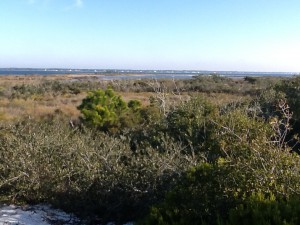
From atop a tertiary dune you can view the maritime forest, salt marsh, and sound beyond. Photo: Rick O’Connor
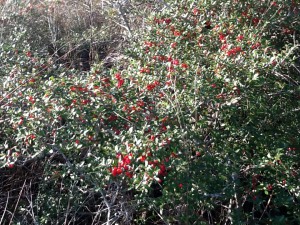
Holly’s are famous for having the bright red berries around Christmas time. Here in January the berries are still found on some of them.
Between the maritime forest and the salt marsh you may find freshwater ponds. Like the swale ponds, these places are great places to find wildlife. Though I have not seen them in many years I have found alligators in this area. These ponds support populations of amphibians and small fishes.
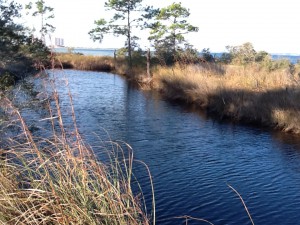
This freshwater pond has bull minnows, amphibians, snakes, and – in the past – alligators. Photo: Rick O’Connor

With the dunes blocking offshore winds trees can grow much larger on the back side of the island; like this live oak.
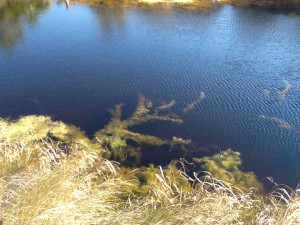
This pond supports a stand of green algae which supports many of the aquatic animals that visit here.
On this winter day I primarily saw bird life. The air temperature was 39 F and the wind was out of the north. Many of the mammals move at night and the reptiles, being cold blooded, were hibernating somewhere; the bird life however was pretty active. Many woodlands birds were out feeding on seeds and berries, herons and egrets were in the marsh hunting fish in the shallow waters, and shorebirds were picking through the beach wrack and some were diving.
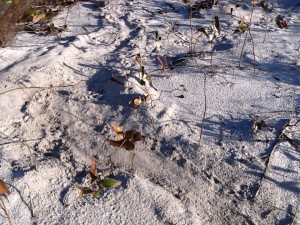
This unusual drag was found between the salt marsh and the sound side shoreline. It looks like a turtle crawl but at his time of year more probable something being dragged by something.
Salt marshes are one of the most productive systems on earth; and the target for another FLORIDA’S PANHANDLE series. Crabs, shrimp, mollusk, worms, terrapins, fish, and birds are some of the wildlife that call this place home – and maybe we will find some as this series continues into the warmer months. Today I found pelicans, herons, and egrets here eating.
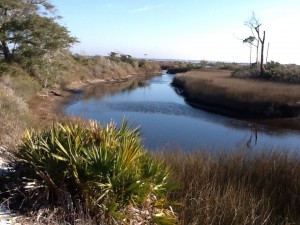
A finger of a salt marsh on Santa Rosa Island. The water here is saline, particularly during high tide. Photo: Rick O’Connor
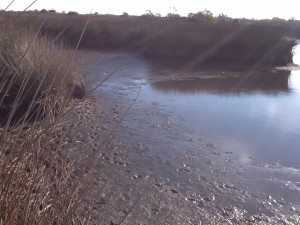
The muck of a salt marsh. This rich organic mud is very loose and the hiker can quickly sink! Notice the tracks of a predator.
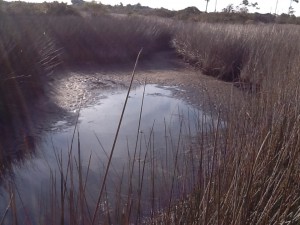
Notice the low water levels typical of winter. This congregates fish into smaller pools and makes it easier for birds and mammals to catch them.
The Sound side of the island has wind but less wind than the Gulf side. The wave energy here is also lower supporting seagrass and oyster communities. Like the marsh these places are very productive; though all I really saw moving on this cold winter morning were the birds. There are two species of seagrass common to our sounds; turtle grass and shoal grass. However there have been reports of more tropical species appearing. We may find some when the water warms up. These waters support at least 100 species of fish and many invertebrates we enjoy eating.
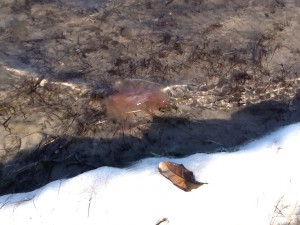
This is a sea nettle. This species of jellyfish has a more painful sting. I only saw one of these today but saw several cannonballs.
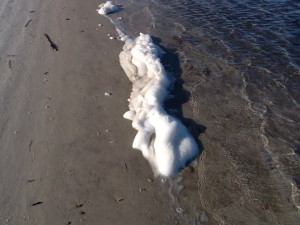
People find this “sea foam” frequently when they visit the beach. It is formed when the winds pick up and there are nutrients in the water. It was up and down the beach today.
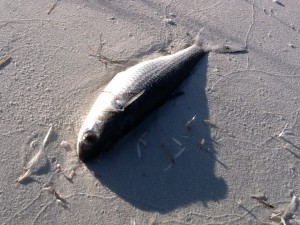
It is not uncommon to find dead fish along the shore after a hard freeze as we have had in recent weeks. When it warms these dead fish will attract scavengers including cottonmouths. Maybe we will see one later in the year.
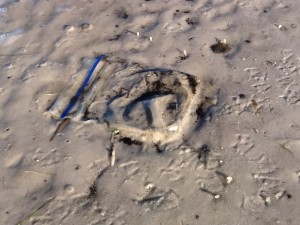
There was very little trash on the island today but it was there. These pieces of debris can cause serious problems for coastal wildlife. We will discuss this issue more as this series moves on.
Well, for January we found the beach to be cold and windy. Very little wildlife was out to be viewed other than birds and the numerous tracks in the dunes, but as the temperatures warm we will see more. Take some time to visit our barrier islands and enjoy them. Until February.
- Searching for Mangroves in the Florida Panhandle - April 6, 2024
- The Swallow-tailed Kites are Back - March 30, 2024
- Beach Wildlife Walk – Late Winter - March 22, 2024

